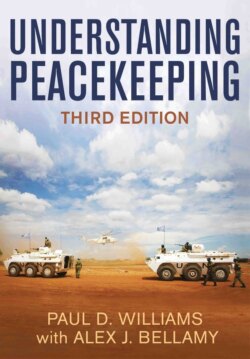Читать книгу Understanding Peacekeeping - Alex J. Bellamy - Страница 43
3 Peace Operations during the Cold War
ОглавлениеPeace operations are not unique to the twentieth century. The idea that great powers have special responsibilities for maintaining peace and security can be traced back to antiquity. The Roman Empire, for instance, established the idea that law enforcement should cross political boundaries (Buzan and Little 2000: 200) and that all peoples were governed by a universal (Roman) law. The origins of modern peace operations lie in attempts by the European great powers in the nineteenth and early twentieth century to manage conflicts, protect imperilled Christians, impose their collective will on other powers, and engage in forms of colonial policing (Chesterman 2001; Finnemore 2003).
The key institutions then were the Concert of Europe and later the League of Nations (see Bellamy and Williams 2010: 71–81). Important threads of continuity and parallels exist between these older activities and what we now call peace operations. For example, it was the League of Nations that established the idea of ‘collective security’ which remains at the heart of the UN system today (see table 3.1). ‘Collective security’ is usually understood as ‘a system, regional or global, in which each participating state accepts that the security of one is the concern of all, and agrees to join in a collective response to aggression. In this sense it is distinct from, and more ambitious than, systems of alliance security, in which groups of states ally with each other, principally against possible external threats’ (Roberts 1996: 310). In the case of the United Nations, this idea was the basis for the Charter rules that left it up to the Security Council to decide what constitutes a threat to, or breach of, international peace and security, as well as the appropriate response (Sarooshi 2000: 285). It was also the League of Nations that developed a form of ‘legalized hierarchy’ that remains evident in the structure of the UN Security Council today, which bestows unique rights and responsibilities upon its permanent members (Simpson 2004).
While recognizing these antecedents is important, this book’s focus is on the period after the formation of the UN system. The rest of this chapter therefore provides an overview of how UN and non-UN peace operations developed during the Cold War period. This is when peace operations as we know them today were ‘invented’ but constrained in important ways by the struggle between the United States and the Soviet Union.
Table 3.1 The United Nations: lessons learned?
| Problem with the League of Nations | Remedy in the UN |
|---|---|
| ‘Empty chairs’ – absence of the US, the USSR, Germany and Japan | ➔ Permanent Security Council members with veto powers; non-permanent members elected by General Assembly |
| Lack of credible enforcement power and international authority | ➔ Chapter VII empowers Security Council to use all means; Article 43 creates a military staff as prelude to international armed force |
| Lack of universality – League became more about collective defence (of Britain and France) than collective security | ➔ General Assembly is all-inclusive – all states can be members; General Assembly oversees the work of the UN, including the Security Council |
| Inactivity and delay | ➔ Creation of a larger, permanent secretariat with technical expertise |
